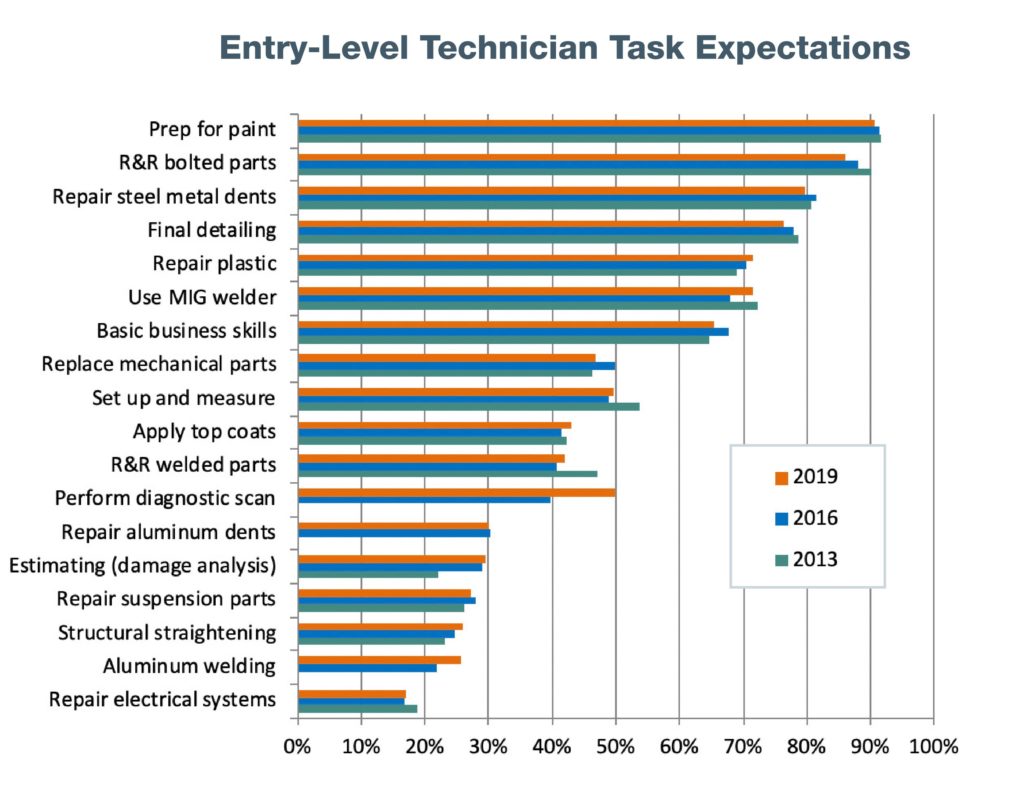
Attack auto body technician shortage by taking SCRS, ASE surveys
By onAnnouncements | Associations | Business Practices | Education | Market Trends | Repair Operations
The Society of Collision Repair Specialists and ASE Education Foundation recently asked the industry to participate in two surveys which could indirectly help alleviate the industry’s skilled labor shortage.
SCRS survey
The SCRS survey is meant for anyone in the industry working as a technician or who has done so in the past. It asks participants about topics including education, preparation for the work and their thoughts on their job and the industry.
“The Society of Collision Repair Specialists (SCRS) has partnered with a number of our industry leaders on a research project to understand how to attract more people to the role of a Collision Technician,” SCRS wrote in an email.
“We are asking for your help: please forward this email to your Collision Repair Technicians and ask them to complete the online survey. Feedback from everyone with Collision Repair experience is important to achieve this important industry goal.”
To participate, click here or visit https://tmp.az1.qualtrics.com/jfe/form/SV_bdORD6J0yIJl8PP.
Based on some of the questions, it sounds like the data could be helpful both in recruiting techs and retaining existing talent. So whether you’re a rookie technician, a veteran repairer or a former tech now working in a different role, help out the industry and take the survey.
ASE Foundation
The ASE Foundation study focuses on the supply side with an end goal of creating an entry-level collision repair school accreditation program.
Right now, ASE Foundation vo-tech collision accreditation demands a facility produce technicians with more skills than an employer might need in an entry-level hire.
By spinning off an entry-level accreditation program with a lower financial bar to entry, it’ll in theory be easier for schools to offer accredited programs and mint technicians that can still satisfy industry needs.
The ASE Foundation’s predecessor NATEF did a similar spinoff in 2012 for mechanical service and repair programs, and apparently it worked out well enough that the organization wants to do it for collision today.
Learn tech shortage solutions during Repairer Driven Education
Find out more about solving your tech shortage — or at least compensating for it — during the upcoming Las Vegas SEMA. Tim Ronak, Charlie Whitaker and Jeff Baker of AkzoNobel will present “Create an in-house technician development program” from 3-5 p.m. Tuesday, Nov. 5, and Shelia Principio, BASF; DeWayen White, Tom Bush Auto-Plex; and Tommy Daniels, BMW, will share “Offset tech shortages with improved efficiency” from 9:30-11:30 a.m. Wednesday, Nov. 6. The sessions are part of the Society of Collision Repair Specialists Repairer Driven Education Series running Nov. 4-8. Register here for individual courses or the series pass package deal, which includes the entire week of classes, all three parts of the OEM Summit, IDEAS Collide and the Nov. 7 Sky Villa afterparty.
Collision Industry Conference Talent Pool Committee member Gene Lopez (Seidner’s Collision Centers) told the July CIC that the ASE Education Foundation’s current task list covers 377 collision repair tasks that a repairer is supposed to be able to complete. According to his presentation, the entry-level version could have just 161 tasks.
The ASE Foundation needs your help to determine what schools need to teach an entry-level tech and what could be cut, perhaps to be learned later on the job or through a training session. Take that survey here.
Lopez, who has been promoting the study, confirmed in an email Tuesday that the survey wasn’t limited to shop owners and managers. Technicians can certainly weigh in as well.
“The ASE Education Foundation, that accredits collision repair academic programs across the country, is asking for your feedback,” an email states. “They are looking to identify your expectations of entry level technician skills. These industry identified skills will inform the revision of the collision repair standards that accredited programs follow. If you aren’t the appropriate contact to provide feedback, please ask the correct person in your organization to complete the survey.” (Emphasis original.)
Newly released Collision Repair Education Foundation and I-CAR research polling more than 675 shops validates the ASE’s Foundation’s plan. It confirms employers can live with entry-level techs trained to do a few things well.
“Survey respondents indicated which tasks they would expect a technical school program graduate to be able to perform with very little supervision,” an executive summary stated. “Respondents chose an average of 9.3 tasks, similar to selections made in 2016 (9.2 tasks).
“The top four requested tasks remained the same, as they have since 1995.”
More information:
Society of Collision Repair Specialists technician and former technician survey
ASE Education Foundation entry-level skills survey
Images:
The Society of Collision Repair Specialists and ASE Education Foundation recently asked the industry to participate in two surveys which could indirectly help alleviate the industry’s skilled labor shortage. (Talaj/iStock)
The basic skills demanded of an entry-level technician remain fairly consistent, according to Collision Repair Education Foundation and I-CAR study results released in 2019. (Provided by CREF)


